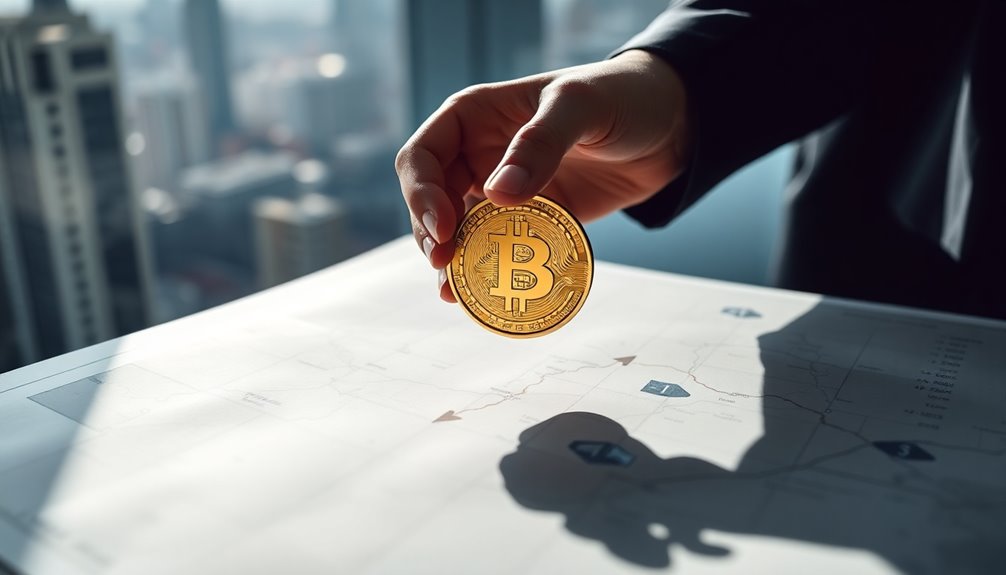Navigating crypto's regulatory landscape can feel overwhelming, but it's essential for your success. You'll need to stay informed about varying frameworks, like the EU's MiCA regulations and US agencies' focus on transparency. KYC and AML requirements are crucial for compliance, but challenges arise from decentralized transactions and overlapping regulations. While regulation offers investor protection and fosters trust, it can also stifle innovation. Be proactive by monitoring government updates, engaging with regulatory bodies, and utilizing diverse information sources. Understanding these dynamics can empower you to navigate this complex terrain effectively, and there's always more to uncover as the landscape evolves.
Key Takeaways
- Stay updated on regulations by monitoring government websites and subscribing to industry newsletters for the latest changes in the crypto landscape.
- Understand the importance of KYC and AML compliance, as these are crucial for navigating regulatory frameworks and avoiding penalties.
- Engage with regulatory bodies through public hearings and direct communication to clarify compliance requirements and provide feedback on proposed regulations.
- Recognize the impact of varying regulations across jurisdictions, as they can create compliance challenges for businesses operating in multiple regions.
- Utilize diverse information sources, such as financial news outlets and industry conferences, to enhance your understanding of evolving regulatory developments in crypto.
Crypto Regulatory Framework Overview

As the crypto landscape continues to evolve, understanding the regulatory framework is crucial for anyone involved in the industry.
You'll notice that different regions adopt varied approaches. The EU's MiCA regulation aims to unify crypto asset rules, ensuring consumer protection across member states.
In the US, agencies like the SEC, CFTC, and FinCEN oversee cryptocurrencies, focusing on transparency and market integrity. Centralized data storage improves the ability of these agencies to monitor compliance and enforce regulations effectively.
Globally, organizations like the IMF and Financial Stability Board work to establish consistent standards, helping to mitigate regulatory arbitrage. These efforts are crucial in maintaining a stable financial environment, especially in times of economic uncertainty. By promoting transparency and sound regulatory frameworks, these organizations aim to ensure that all financial institutions operate on a level playing field. In this context, liquidity providers explained how their role is fundamental in facilitating market efficiency, providing the necessary capital flow to support economic activities while adhering to these established standards.
By staying informed about these regulatory efforts, you can better navigate the complexities of the crypto market, ensuring compliance and fostering trust in your crypto endeavors.
Understanding this framework is essential for long-term success.
Regulatory Challenges in Crypto

Navigating the regulatory challenges in crypto can feel overwhelming, especially given the sector's rapid evolution.
The decentralized nature of transactions complicates identifying involved parties and creates regulatory gaps, as governments struggle to keep pace with technology. Anonymity issues in distributed ledger technology heighten risks of financial crimes like money laundering. Additionally, the complexity of jurisdiction means multiple regulators may have overlapping authority, leading to confusion. Consumer protection is crucial, with regulators focusing on fraud prevention, cybersecurity, and market integrity. In light of the increased scrutiny from regulators due to market volatility and fraud concerns, you'll also face scrutiny over compliance with Anti-Money Laundering (AML) and Know Your Customer (KYC) requirements. Without clear guidelines, ensuring compliance becomes a daunting task for anyone involved in the crypto space.
Transaction Verification Process

Regulatory challenges in the crypto space underscore the importance of a reliable transaction verification process.
In this process, you use public and private keys to authenticate transactions. When you create a transaction, you'll sign it with your private key, proving ownership. Nodes then validate the signed transaction, employing cryptographic protocols to ensure its integrity. Bitcoin transactions involve the exchange of Bitcoin between two parties on the network.
Consensus models, like proof-of-work and proof-of-stake, help secure agreement among network participants. Each node checks the transaction before it's added to the blockchain, making it permanent and immutable.
Additionally, blockchain explorers allow you to track transactions, ensuring transparency and accountability. By understanding this verification process, you can navigate the complexities of crypto transactions more effectively.
Pros and Cons of Regulation

While the debate over crypto regulation continues to unfold, it's essential to weigh both the pros and cons to understand its impact on the industry.
On one hand, regulation can provide investor protection, discouraging fraud and promoting market stability. It also legitimizes the crypto space, fostering trust and transparency, which can lead to more secure adoption of digital assets. Moreover, the U.S. regulatory environment features variances in crypto regulation at federal and state levels, which can create complex compliance challenges for businesses.
However, regulation can stifle innovation, contradicting the decentralized nature of crypto and potentially excluding valuable projects from funding opportunities. Additionally, it may lead to increased complexity and limitations for less wealthy investors, raising concerns about privacy and government monitoring.
Balancing these factors is crucial as you navigate the evolving landscape of crypto regulation.
Regulation vs. Innovation Balance

The ongoing debate about crypto regulation highlights a pressing need to find a balance between regulatory oversight and the spirit of innovation that fuels the industry.
While regulators implement Know Your Customer (KYC) and Anti-Money Laundering (AML) frameworks to protect consumers, excessive rules can stifle the creativity essential for growth. Global regulators focus on anti-money laundering (AML) and fraud prevention ensures that innovative projects adhere to necessary standards without compromising their unique offerings.
Regulatory sandboxes present a solution, allowing startups to test their innovations in a controlled environment.
Engaging in continuous dialogue with the DeFi community ensures regulations evolve without hampering progress.
Global cooperation is vital to streamline frameworks, attracting entities eager to innovate within a regulated landscape.
Ultimately, the challenge lies in fostering an environment where innovation thrives alongside necessary compliance, steering clear of both overregulation and under-protection.
Market Volatility Concerns

Market volatility in the crypto space can be both thrilling and daunting, especially when you consider how quickly prices can shift.
Limited supply, like Bitcoin's cap of 21 million coins, can spark sharp price increases during sudden demand surges. The influence of large holders, or whales, further exacerbates this volatility, as their trading activities can lead to rapid price swings. Additionally, fluctuating demand driven by investor sentiment and speculation creates a dynamic market environment. In a 24/7 trading world, psychological factors like fear and greed play a significant role, pushing investors toward panic buying or selling. Importantly, the influence of government regulations can also create uncertainty, further complicating the decision-making process for investors. Moreover, the rise of trading bots has introduced new complexities, as these automated systems can react to market changes much faster than human traders.
Together, these elements create a landscape where opportunities and risks coexist, demanding careful navigation from you as an investor.
Emerging Stablecoin Regulations

As regulatory scrutiny intensifies, understanding the emerging landscape of stablecoin regulations becomes crucial for investors and issuers alike.
In the U.S., the SEC and CFTC differ on whether stablecoins are securities or commodities, creating uncertainty. States like Texas enforce money transmission laws, while the OCC has affirmed banks' ability to custody stablecoins. This regulatory ambiguity is compounded by the fact that stablecoins are often viewed as a bridge between volatile cryptocurrencies and traditional finance.
Meanwhile, the EU's MiCA regulation mandates reserves on a 1-to-1 basis and prohibits algorithm-based stablecoins.
Internationally, the Monetary Authority of Singapore has established a robust framework, focusing on stability and transparency.
As these regulations evolve, compliance challenges, such as KYC and AML requirements, will require your close attention to navigate this complex regulatory environment effectively.
Stay Updated on Regulations

How can you stay informed in the fast-evolving world of cryptocurrency regulations?
Start by monitoring government websites for official announcements, regulatory alerts, and legislative updates. Public hearings also provide valuable insights into regulatory perspectives.
Next, subscribe to industry newsletters and read expert opinions to grasp the latest developments. Utilize financial news outlets and specialized crypto news sites for real-time updates. Staying updated on global regulatory responses can also enhance your understanding of how different countries approach cryptocurrency.
Engaging with regulatory agencies is crucial too; reach out for clarification and submit comments on proposed regulations.
Lastly, leverage social media, podcasts, and webinars to access diverse viewpoints.
Frequently Asked Questions
How Do Different Countries Regulate Cryptocurrencies Differently?
Different countries regulate cryptocurrencies in unique ways.
For instance, the EU's MiCA requires licenses for crypto companies, while Japan recognizes cryptocurrencies as legal property.
South Korea emphasizes user protection through specific legislation, whereas China enforces strict bans on transactions.
In Britain, firms need FCA authorization, and Brazil's central bank supervises crypto activities to prevent scams.
Each approach reflects local priorities and concerns, shaping how you interact with digital assets globally.
What Are the Penalties for Non-Compliance With Crypto Regulations?
If you think ignoring crypto regulations won't cost you, think again!
The penalties for non-compliance can be staggering—fines can reach into billions, and criminal charges could land you in prison!
You're looking at steep fees for AML violations, with the IRS ready to slap a 75% penalty on undeclared crypto income.
Can Regulations Stifle Cryptocurrency Innovation in the Long Term?
Yes, regulations can stifle cryptocurrency innovation in the long term.
When compliance costs rise and complex rules emerge, startups like yours may struggle to enter the market. Excessive regulation might force innovative projects to relocate, while strict guidelines can limit creative experimentation.
Additionally, uncertainty about changing regulations can scare away potential investors, ultimately hindering growth.
To foster innovation, it's crucial that regulations strike a balance between oversight and encouraging new ideas.
How Does Taxation Work for Cryptocurrency Transactions?
When you dive into the world of cryptocurrency, think of it as a dance with taxes. Each transaction you make—selling, trading, or spending—triggers a step in capital gains tax.
If you've held your crypto for over a year, you might waltz into lower rates! But if you earn it through mining or staking, it's ordinary income.
What Role Do Decentralized Exchanges Play in Regulation?
Decentralized exchanges (DEXs) play a crucial role in the evolving regulatory landscape. They challenge traditional compliance methods due to their anonymous nature and lack of central oversight.
You'll find that DEXs can utilize smart contracts for automated compliance, helping them navigate complex regulations.
However, as they face jurisdictional issues and potential penalties, they must stay updated on regulatory changes to maintain user trust and foster innovation without compromising their core decentralized principles.
Conclusion
As you navigate the ever-evolving crypto regulatory landscape, remember that staying informed is your best ally. The balance between regulation and innovation hangs by a thread, and one unexpected shift could change everything. Will the new rules empower or stifle your investments? The looming questions of market volatility and stablecoin regulations add to the uncertainty. Keep your finger on the pulse, because in this world, the next headline might just reshape your crypto journey forever.









